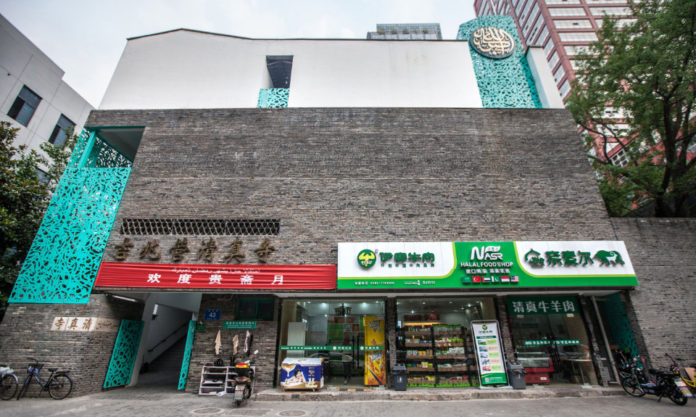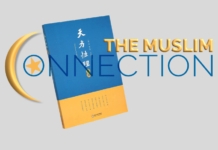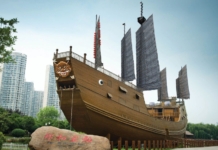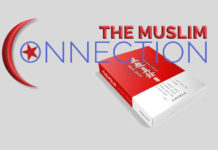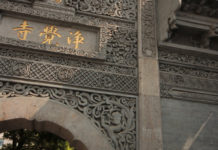Mosques are easy to find due to their tall minarets, as some of the clearest visible symbols of Muslim communities.
But in China, however, the Arab architectural approach with onion domes and tall skinny minarets is less common. Instead, many of Nanjing’s and early Chinese mosques are a reflection of traditional Chinese architectural elements, with complex tiling, curved roofs and multiple buildings within a courtyard-like design.
At the peak of its Muslim population, Nanjing was home to 36 mosques. Purportedly, the first was established in the Song Dynasty near today’s Fengfu Lu and named Yikesong Mosque (一棵松清真寺), after the ancient pine tree that stood near its entrance.
In the Ming Dynasty, 11 mosques were built, while the Qing Dynasty saw an additional 24 established. In the Republican Era, another 13 were built alongside five female Arabic/Chinese schools, with one more mosque added after the founding of PRC.
The quick and successive cropping up of such spaces reflected the population’s growing needs beyond dietary elements. Increasingly, local Muslims began seeking systematic responses to spiritual, religious and emotional aspects.
And it was through the mosques and their related services and institutions that these needs began to be met.
On the outskirts of Nanjing, entire Hui villages grew in Liuhe District (六合区), Zhuzhen (竹镇) and Hushu (湖熟).
Today, Hushu’s mosque still operates, catering largely to foreign students in neighbouring universities, while both Liuhe’s and Zhuzhen’s native populations have held onto official signs denoting their Hui minority villages.
Today however, the locals only identify ethnically as Hui and original mosques are largely shuttered.
In the 18th and 19th centuries, the groundwork laid by Nanjing Muslim intellectuals, such as Liu Zhi and Wang Daiyu, who re-introduced and explained Islamic principles in terms of already well-known Confucian concepts, set the precedent for modern-day Chinese terms for Islam.
Their work led to the growth of the Nanjing-based Jinling (one of Nanjing’s old names) approach (金陵学派/jinling xuepai) to jingtangjiaoyu (经堂教育) or a formal Islamic institution.
Multiple religious schools, typically affiliated to operating mosques, were opened to educate Sino-Muslims of religious principles, Arabic-language learning and specific prayers, beginning with elementary-age students.
Graduates would be expected to be able to lead or perform religious rituals and services for locals. A later column will address this unique trend and the Chinese Islam’s unique Neo-Confucian-rooted language, which began with Nanjing Muslims.
The late 19th century and 20th century were periods of great destruction for Nanjing mosques. The Taiping Rebellion alone burned or destroyed each of these 36 mosques when Nanjing was under their control.
Dilapidated until the late 19th century, 24 mosques underwent multiple renovations in order to reopen. In the case of Jingjue Mosque (净觉寺), the original one-square kilometre site was whittled down to 4,000 square metres, today retaining only a tiny little square of its original architecture in the northeastern corner of the mosque’s flooring.
In the early 20th century, local Mandarin-speaking Muslims began actively to re-establish their identity. While Muslims began as traders and merchants of Persian, Central Asian or Arab lineage, they had intermarried and generationally became culturally in-sync with other non-Muslim locals. And so, though modern China’s founder Sun Yat-sen recognised the significance of Hui in his “five minorities” category, Nanjing Muslims of the early 1900s felt that the term failed to encompass their geographic, linguistic and cultural image. Instead, the term was more commonly used to refer to the “Chanhui” (缠回) or literally, the “Turbaned Hui”, a Qing Dynasty term that typically referred to Qinghai and Xinjiang Muslims of Kazakh or Uyghur ethnic backgrounds.
It was then shortly after the Xinhai Revolution, that 39 Nanjing Hui individuals established the Chinese Hui Religion Association (中国回教联合会) in 1912. The Association, headquartered in today’s Caoqiao Mosque (currently on Fengfu Lu). went on to establish 40 branches and was the first of local efforts to signal an attempt to reclaim a difference between “Huimin” (回民; ethnically Hui) and “Huijiao” (回教; religiously Hui/Muslim).
During this time of overall sentiment toward revolutionary efforts to reshape the country, Nanjing Muslims too envisioned and sought to voice their own interests for the future.
And so, when Japanese military members staged the Mukden Incident in 1931 as an excuse to invade China, a sudden boom in local Muslim publications flooded the market.
Writers focused on anti-Japanese rhetoric, calls to action, explanation and the connecting of religious texts to current-day situations. They also published research on Muslim-majority regions in China.
After 1957, some 27 of Nanjing’s mosques fell into disarray, while another 18 were demolished to make way for streets or neighbourhoods. The Cultural Revolution in the 1960s led to a complete halt to religious activity.
It was not until after the Reform and Opening Up in 1978, that slowly, mosques such as Jingjue and Jizhaoying (吉兆营清真寺) were allowed to be renovated for operation once more. Today, the Caoqiao Mosque (草桥清真寺) on Dingxin Lu is the third remaining city-centre mosque in operation.
Mosques, like many places of worship, operate as central points for religious communities. For the Muslims of Nanjing, this was no exception. Though only a fraction of their original number, today these institutions are the remaining physical marker of the starting point for many notable Nanjing Muslims, a few of whom we will go on to meet next.


